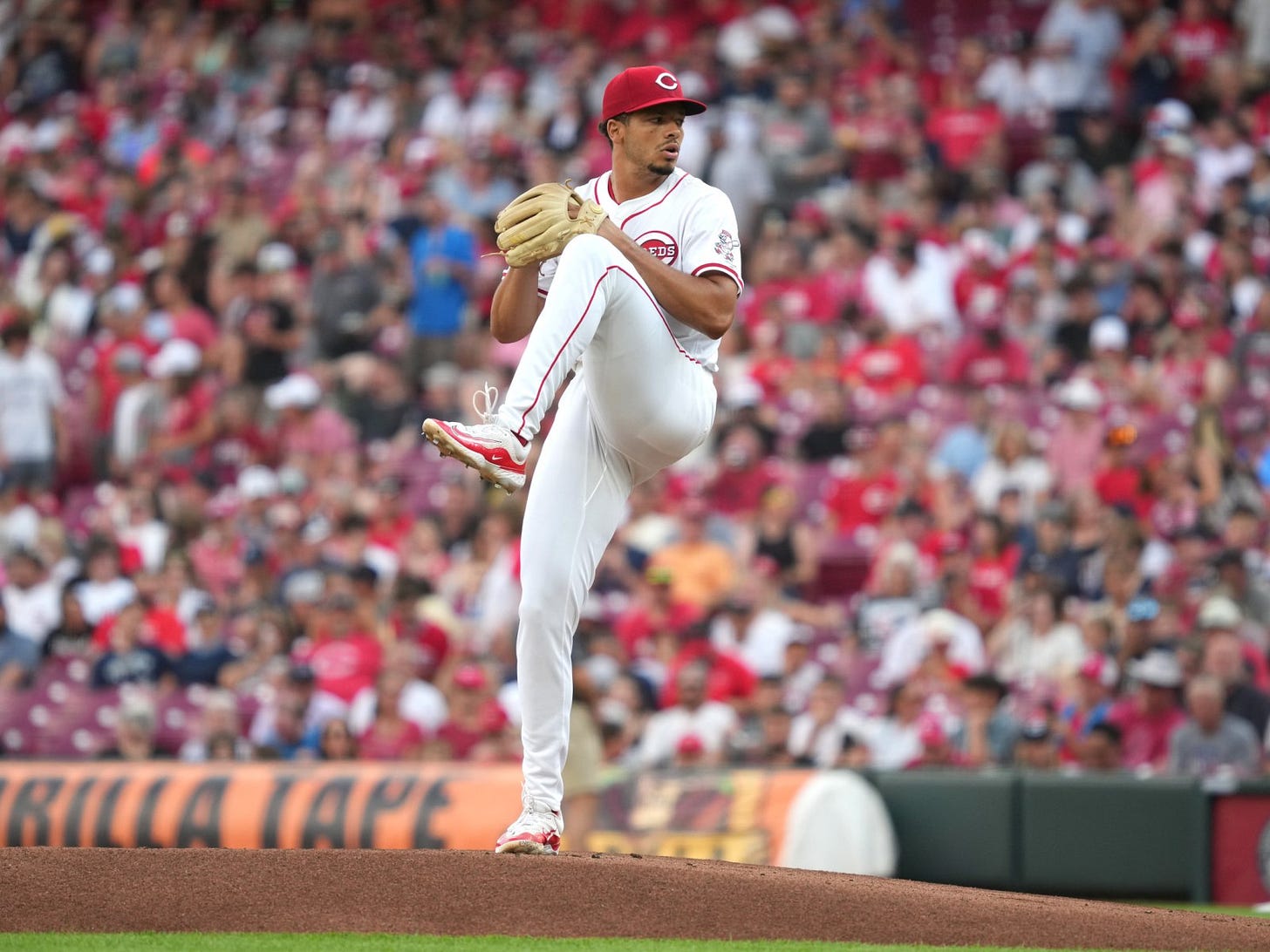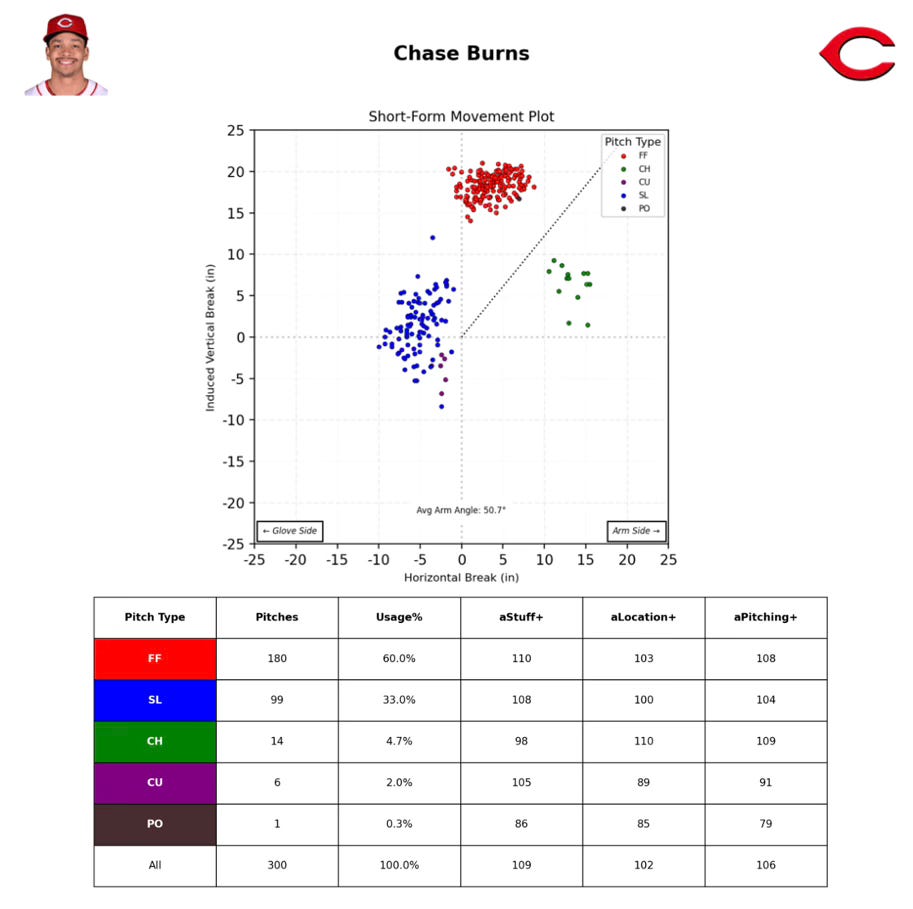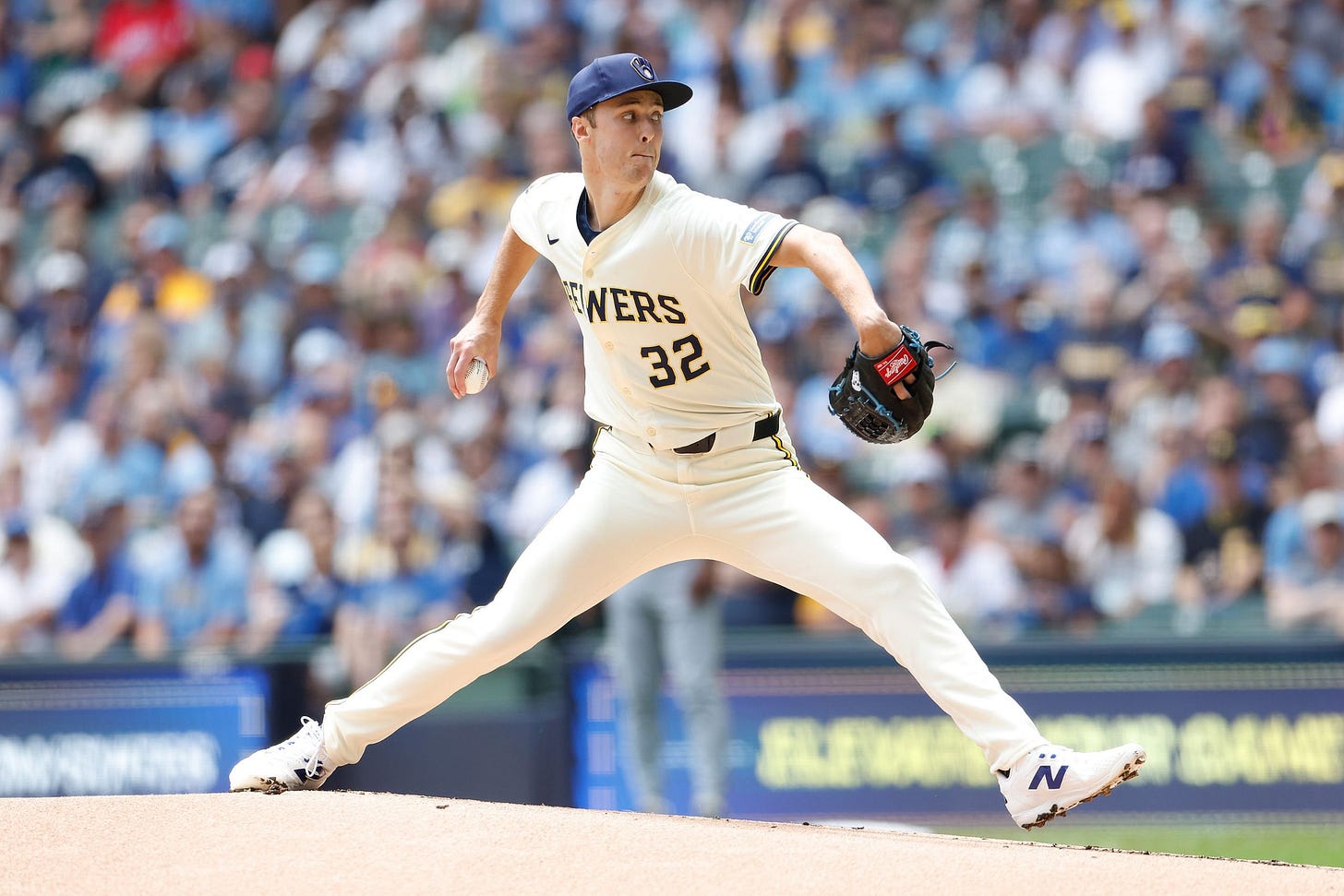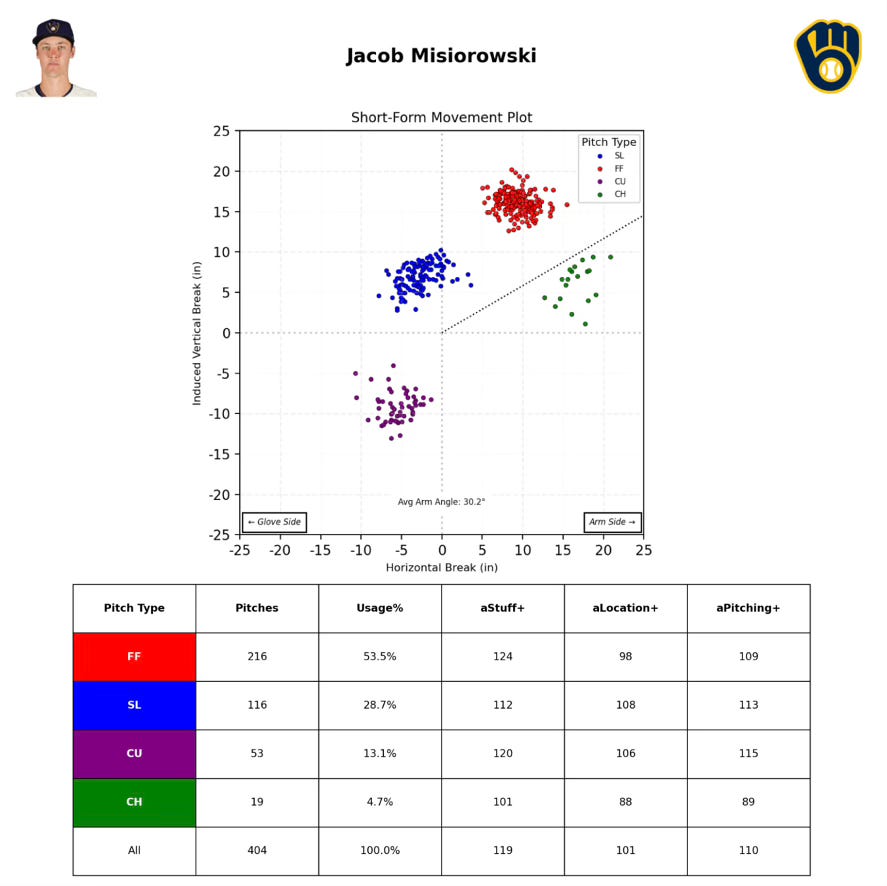Unpacking Chase Burns and Jacob Misiorowski
A closer look at two of MLB’s most electric young starting pitchers.
In my opinion, one of the most exciting developments that has occurred during the first half of the 2025 Major League Baseball season has been the debuts of numerous exciting starting pitchers. While much of the attention has been placed on the historic Major League debut of Jacob Misiorowski of the Milwaukee Brewers, there have also been exciting performances by rookie pitchers such as Chase Burns, Cade Horton, Didier Fuentes, and Cam Schlitter. A young, controllable starting pitcher is one of the most valuable assets an organization can possess in the modern game (as evident by the trade package the Chicago White Sox received for Garrett Crochet last offseason), and the everlasting need for pitching depth at the Major League level has resulted in many organizations placing significant resources into pitching development, not only allowing them to produce many bullpen arms but also to maximize potential of their young “future aces”. This article will take a look at the Major League debuts of Chase Burns and Jacob Misiorowski, analyze why their pitch arsenals provide them with solid foundations for success, and attempt to identify paths forward for future development to maximize their full potential.
Chase Burns (RHP - Cincinnati Reds):
Drafted 2nd overall in the 2024 MLB Draft by the Cincinnati Reds, Chase Burns has been one of the most electrifying pitching prospects in recent memory. Featuring a heavy fastball-slider mix, Burns has consistently shown off his dominant stuff throughout his amateur and college career, and has the potential to be one of the best starting pitchers in Major League Baseball with further refinement to his pitch arsenal.
As shown by the movement plot above, Burns features four pitches in his pitch arsenal: a four-seam fastball, a slider, a changeup, and a curveball. Against right-handed hitters, Burns solely uses the four-seamer (56.2% usage) and slider (43.1% usage), while he’ll mix in the changeup and curveball while dialing back the slider usage against left-handed hitters. By measure of aStuff+, Burns’s best pitch is his four-seam fastball, with the pitch grading as a 110 aStuff+ due to its plus velocity and vertical acceleration. Burns’s slider is not far behind with a 108 aStuff+, due to the pitch generating ~5 inches of horizontal movement at ~90 MPH, with the pitch projecting to be an effective offering for generating swing-and-miss against right-handed hitters long-term.
The four-seamer and slider have been the centerpieces of Burns’s arsenal since his time at Wake Forest, with the four-seamer grading as a 117 aStuff+ and the slider grading as a 110 aStuff+ during a Statcast-tracked game last season. As a side note, Burns’s track record of pitching with both a NCAA and MLB baseball provides some context as to how the different baseballs can generate different movement patterns, as Burns’s fastball in college generated nearly 2 more inches of induced vertical movement than his fastball at the Major League level, despite throwing the pitch at the same velocity and release point at both levels. I highly recommend watching Lance Brozdowski’s video on how the difference in the baseball’s composition at different levels can impact pitch movement. It appears that the Reds made a tweak to have Burns throw his slider harder and at a tighter shape upon arriving in the organization, as the offering went from averaging 8 inches of horizontal movement at 87.4 MPH at the college level to averaging 5.2 inches of horizontal movement at 89.9 MPH upon arrival at the MLB level.
Despite displaying a 12.2% walk rate over his first 4 Major League starts, Burns currently possesses a 102 aLocation+ and 105 FGLocation+, and I believe that his ability to command the baseball might be a bit underrated. Yes, 300 pitches is below the threshold where location modeling metrics become a reliable, and command can be volatile throughout a season given the inherent difficulty in locating a baseball, however, Burns has displayed below-average walk rates throughout his amateur and professional career which I believe could portend for him running a walk rate near league-average over the long-run.
Visually, Burns has what many scouts would refer to as a “high effort” delivery, and I recall that some analysts believed that Burns had more “reliever risk” present entering the 2024 Draft than fellow 1st round pick Hagen Smith. In scouting parlance, a “high effort” delivery tends to lead to the belief that the pitcher does not possess a delivery that is repeatable mechanically, leading to decreased command and an eventual move to the bullpen. As written in Eric Logenhagen’s scouting report of Burns, “Burns’ mechanical operation requires a lot of effort and it detracts from his command”, likely leading to FanGraphs’s 30/45 command grade on Burns entering the season. While there is a weight to be placed on these visual observations of his delivery, Burns consistently produced sub-8% walk rates in college and produced a 5.4% walk rate in the Minors this season. Perhaps hitters at these levels are simply chasing at pitches more frequently than Major League hitters would, inflating Burns’s chase-whiff%; however, the statistical track record that Burns has shown in this regard provides me with confidence that he will settle around a league-average walk rate and remain in the starting rotation long-term.
Burns has been off to an impressive start in his Major League career, however; there are a couple of ways in which he can refine his arsenal to improve his overall ceiling as a starting pitcher. First, I would be intrigued to see if he could improve his curveball to give it a bigger shape that could be utilized early in the count for called strikes. Possessing 92% spin efficiency on his four-seam fastball, it appears that Burns leans towards supination bias, and if he can get his curveball to a shape that can get to at least 12 inches of drop at greater than 80 MPH, then it would give him an offering that he could use for called strikes early in the counts, and could mix in later in counts as an additional swing-and-miss weapon. Second, if Burns runs into difficulties against right-handed hitters “sitting” against his four-seam fastball, I believe he would be a good candidate to add a sinker to his arsenal. Adding a second fastball to a pitch arsenal introduces the possibility that the opposing hitter could anticipate the wrong fastball being utilized, resulting in either sub-optimal contact or swing-and-miss. Adding a sinker to his arsenal will likely allow Burns to generate both more sub-optimal contact when hitters incorrectly determine a four-seamer is approaching, and more whiffs on the four-seam fastball when hitters incorrectly anticipate a sinker. Burns’s arm angle is likely too high to add a one-seam sinker that gets close to the “zero line” of induced vertical break like Max Fried, but I think adding a sinker similar to how Tyler Glasnow added one to his arsenal last season could be an effective blueprint for Burns to add to his existing pitch repertoire. Overall, Burns has displayed an excellent foundation for long-term success with his high-stuff four-seam fastball and slider this season, and with further refinement to his pitch arsenal, he could solidify his role as one of the top two starting pitchers in the Cincinnati Reds starting rotation for the foreseeable future.
Jacob Misiorowski (RHP - Milwaukee Brewers):
Drafted with the 63rd overall pick of the 2022 MLB Draft by the Milwaukee Brewers, Jacob Misiorowski has been one of the more intriguing prospects in Major League Baseball over the past couple of seasons. Standing tall and lean at 6’7” and 197 pounds, Misiorowski displayed command troubles throughout his time as a prospect, leading some evaluators to believe that his long-term future was in the bullpen, not the starting rotation. Misiorowski’s command ability has improved this season as he has gotten more comfortable with controlling his long limbs, providing more confidence he can stay in the rotation long-term which, when combined with his elite stuff ability, has elevated Misiorowski’s ceiling to potentially being one of the best starting pitchers in all of Major League Baseball.
As shown by the movement plot above, Misiorowski’s arsenal features four pitches in his pitch arsenal: a four-seam fastball, a slider, a changeup, and a curveball. Against right-handed hitters, Misiorowski utilizes the four-seamer, slider, and curveball, while utilizing his changeup exclusively against left-handed hitters. To put it frankly. Misiorowski’s stuff is absurd. Misiorowski’s 119 aStuff+ ranks as the 3rd-best among all pitchers (starters and relievers) in Major League Baseball, headlined by his four-seam fastball, which grades as a 124 aStuff+. Misiorowski’s slider and curveball are also graded as elite pitches by aStuff+, while his changeup (which pitch models can have difficulties evaluating) grades as a 101 aStuff+.
The main development of Misiorowski’s arsenal this season has been his improved command ability. Throughout his tenure in the Minors, Misiorowski consistently displayed walk rates greater than 13%, which he has gotten down to 11.2% to begin his Major League career. Location models have agreed with the improvement in Misiorowski’s command ability, with aLocation+ and FanGraphs’ Location+ grading his locations as a 101, with LocationBot (which uses a 20-80 scale) grading his locations as a 59. Misiorowski’s Minor League aLocation+ values also display this improvement in command, as he displayed a 94 aLocation+ over 295 AAA pitches in 2024, and a 98 aLocation+ over 1,005 AAA pitches in 2025. Given his historical track record, I would expect Misiorowski’s location grades to regress closer to league-average over the remainder of the season, however, his command ability has definitely improved from last season, and as long as he is generating strikeouts at a high rate, should be enough to allow for a role in the starting rotation long-term.
Given his dominance to begin his Major League career, I wouldn’t recommend making any changes to his pitch arsenal in the short term, however; I do believe there are a couple of avenues in which Misiorowski can add or tweak an offering in his arsenal to further elevate his current level of production. Possessing 91% spin efficiency on his four-seam fastball and the ability to throw breaking pitches at high velocity, it appears that Misiorowski leans towards supination bias, and similar to Burnes, Misiorowski would likely benefit from adding a sinker to his arsenal to utilize against right-handed hitters. At a 30-degree arm angle, Misiorowski would likely be able to throw a one-seam sinker that would get close to the “zero line” of induced vertical movement, allowing him with to generate both more sub-optimal contact when hitters incorrectly determine a four-seamer is approaching, and more whiffs on the four-seam fastball when hitters incorrectly anticipate a sinker. In addition to adding a sinker, there could be room to tinker with the shape of Misiorowski’s changeup. While he possesses supinator traits, Misiorowski currently pronates his changeup, with the changeup currently displaying a 99% spin efficiency, and I wonder if he could be a candidate to switch to a kick changeup grip. Kick changeups are typically difficult to command, so I am not sure if Misiorowski is the best candidate to switch to this orientation, however, if he does switch to a kick change it would be unsurprising if it takes a similar shape to Andrés Muñoz’s changeup and become a swing-and-miss machine, especially against left-handed hitters.
While Misiorowski’s current arsenal is electric, it would be incomplete to talk about Misiorowski without discussing his inherent injury risk. Pitchers who throw at both ranges of the velocity spectrum are very susceptible to developing arm injuries; however, it appears that Misiorowski will be particularly vulnerable given his ability to throw all of his pitches at extremely high velocities. I really do not like to speculate on the injury potential of pitchers, as Major League organizations with substantial access to biomechanical and medical data have difficulty accurately evaluating injury risk, however, Misiorowski’s ability to throw at extreme levels of velocity not only allows him to have a high ceiling as a top-of-the-rotation starter, but also provides him with elevated injury risk moving forward. As one of the smartest organizations in the league, the Brewers are certainly keeping a close eye on his health and durability, and I would imagine that Misiorowski will be on a tight innings limit over the remainder of the 2025 season.
Thanks for reading!
Follow @MLBDailyStats_ on X and Adam Salorio on Substack for more in-depth MLB analysis. Photo credits to Getty Images.











